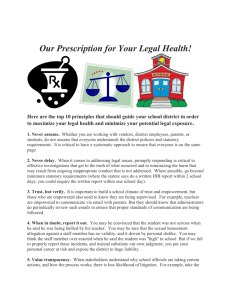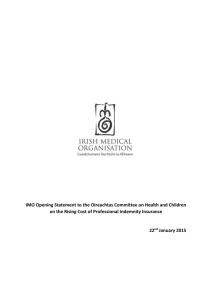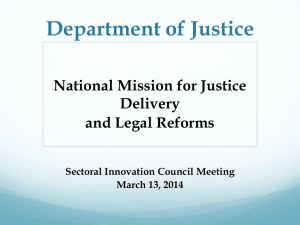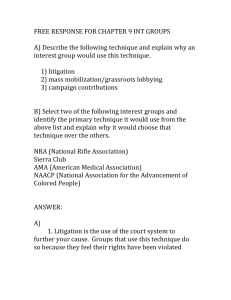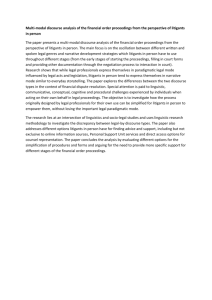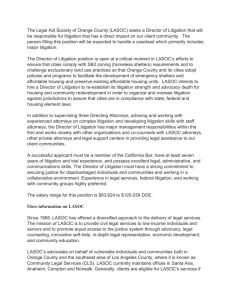Safety Underground: Mining and the Miners` Lamp
advertisement
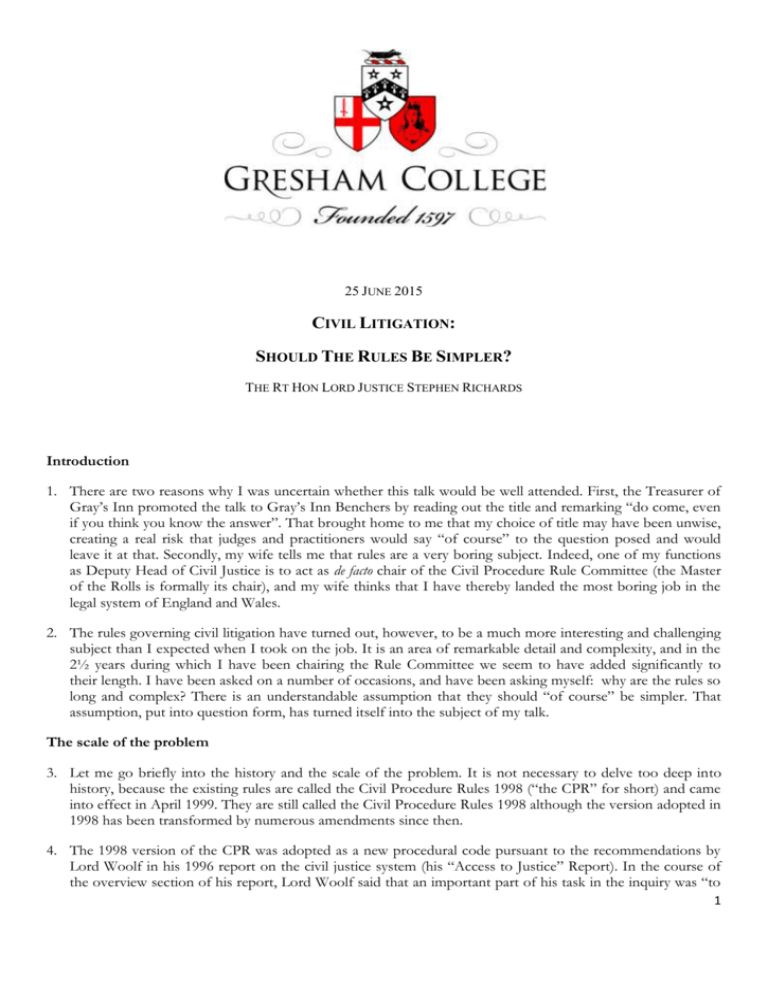
25 JUNE 2015 CIVIL LITIGATION: SHOULD THE RULES BE SIMPLER? THE RT HON LORD JUSTICE STEPHEN RICHARDS Introduction 1. There are two reasons why I was uncertain whether this talk would be well attended. First, the Treasurer of Gray’s Inn promoted the talk to Gray’s Inn Benchers by reading out the title and remarking “do come, even if you think you know the answer”. That brought home to me that my choice of title may have been unwise, creating a real risk that judges and practitioners would say “of course” to the question posed and would leave it at that. Secondly, my wife tells me that rules are a very boring subject. Indeed, one of my functions as Deputy Head of Civil Justice is to act as de facto chair of the Civil Procedure Rule Committee (the Master of the Rolls is formally its chair), and my wife thinks that I have thereby landed the most boring job in the legal system of England and Wales. 2. The rules governing civil litigation have turned out, however, to be a much more interesting and challenging subject than I expected when I took on the job. It is an area of remarkable detail and complexity, and in the 2½ years during which I have been chairing the Rule Committee we seem to have added significantly to their length. I have been asked on a number of occasions, and have been asking myself: why are the rules so long and complex? There is an understandable assumption that they should “of course” be simpler. That assumption, put into question form, has turned itself into the subject of my talk. The scale of the problem 3. Let me go briefly into the history and the scale of the problem. It is not necessary to delve too deep into history, because the existing rules are called the Civil Procedure Rules 1998 (“the CPR” for short) and came into effect in April 1999. They are still called the Civil Procedure Rules 1998 although the version adopted in 1998 has been transformed by numerous amendments since then. 4. The 1998 version of the CPR was adopted as a new procedural code pursuant to the recommendations by Lord Woolf in his 1996 report on the civil justice system (his “Access to Justice” Report). In the course of the overview section of his report, Lord Woolf said that an important part of his task in the inquiry was “to 1 produce a single, simpler procedural code to apply to civil litigation in the High Court and county courts” (page 4, paragraph 7). The chapter on the new rules explained that he had set himself five specific objectives for the rule-making exercise: (i) to identify the core propositions in the rules and to cut down the number of interconnecting provisions which were used; (ii) to provide procedures which applied to the broadest possible range of cases and to reduce the number of instances in which a separate regime was provided for a special type of case; (iii) to reduce the size of the rules and the number of propositions contained in them; (iv) to remove verbiage and to adopt a simpler and plainer style of drafting; and (v) to give effect to the substantive reforms which he was proposing in his report. He said that the approach adopted would reduce complexity and make the system more amenable to actual users and more acceptable to ordinary citizens, whether litigants or not; it should reduce the learning and processing costs of courts and lawyers (page 272, Chapter 20, paragraphs 2 and 4.) 5. If the rules in their present form reflected the commendable process of simplification aspired to by Lord Woolf, I would have nothing to talk about this evening. But things have not turned out as Lord Woolf expected them to. 6. I can give a broad illustration of the point by referring to the White Book, which is the civil legal practitioner’s procedural bible. It contains the rules and a commentary on them. Like the bible, there are very few people who could claim to have read it from cover to cover; but unlike the bible, there is nobody who would want to read it from cover to cover or to have it with them on their desert island. The White Book comes out in a new edition each year, to the profit of its publisher and the financial detriment of legal practitioners and law libraries. The very fact that one needs a new edition every year is not bad evidence in itself of the existence of a problem. But I can be more specific than that: (1) The 1999 edition of the White Book was the last edition containing the old rules, i.e. those replaced by the Civil Procedure Rules 1998. In those pre-CPR days there were separate rules for the High Court and the Court of Appeal on the one hand and for the county courts on the other hand – the removal of that duplication, so as to have a single set of rules for all the civil courts, was one of Lord Woolf’s objectives for the new procedural code. Almost all the old rules were contained in a single volume, i.e. Volume 1 of the White Book. The rules and commentary in Volume 1 occupied just fewer than 2,200 pages in total. But in fairness, I should also take account of a section in Volume 2 which contained various related practice directions, taking up a further 200 pages or so. So, between the two volumes, a total figure not far short of 2,400 pages. (2) The 2015 edition of the White Book is appreciably fatter. Volume 1 contains many but by no means all of the current rules, together with their supplemental practice directions and pre-action protocols (a category of document which I will explain in a moment) and accompanying commentary. It is fair to say that some of the rules relating to costs appear in their pre-1 April 2013 version as well as their post-1 April 2013 version, so there is a significant element of duplication in that area. But that is hardly a mitigating factor, since the very fact that both versions have to be included, to cover cases started or heard at different times, is a further indication of the overall complexity of the situation. Because there is insufficient room in Volume 1 for all the rules, you now have to turn to Volume 2 to find the rules and practice directions relating to various categories of proceedings: for example, proceedings in the Commercial Court, intellectual property claims, and special procedures under terrorism legislation. Taking Volume 1 and the relevant sections of Volume 2 together, there is a total in the region of 3,200 pages, an increase in size of about one third over the 1999 White Book. 7. What this means is that what was intended to be a simplified procedural code has turned out to be substantially larger and more complex than the body of rules it replaced. 8. The increase in size is not the result of fewer rules and longer commentary; everything has grown. You can go to the online version of the rules to see them without any commentary and you will find it a pretty formidable exercise to run through them. I have to say that without a commentary the rules can seem even more formidable than with a commentary. The structure of the rules 2 9. It may help if, before I go on, I explain briefly how the rules are structured. The Civil Procedure Rules themselves are divided into Parts, currently numbered from Part 1 to Part 88. Each Part contains detailed rules on a particular topic. Many of the parts are supplemented by one or more practice directions to which I have already made reference: (1) The rules themselves are made by the Rule Committee, subject to the approval of the Master of the Rolls and the Lord Chancellor and also subject to a Parliamentary procedure, in that they are contained in a statutory instrument a draft of which has to be laid before Parliament, where the negative resolution procedure applies to it (i.e. it comes into force after a defined period of time unless Parliament passes a resolution against it). The original statutory instrument containing the Civil Procedure Rules 1998 has not been replaced but has been amended time and time again to produce the rules in their present form. In 2014, for example, there were 8 amending statutory instruments; the last of them entitled, unsurprisingly, The Civil Procedure (Amendment No.8) Rules 2014. The amending statutory instruments are often unintelligible if read by themselves since they contain only the changes – additions, subtractions or substitutions – rather than a composite version of the amended rules. You have to look in the White Book or an equivalent practitioner’s work, or at the online version of the rules, to find a consolidated version. To find the version in force at some earlier date you have to delve into previous editions of the White Book and its periodic supplements, or embark upon an online search of considerable difficulty – a problem that needs to be addressed. (2) Practice directions are not subject to a Parliamentary procedure; they are made by the Master of the Rolls on the advice of the Rule Committee and subject to the approval of the Lord Chancellor, and they are published separately from the rules. In principle, because there is no involvement of Parliament, they can be amended more readily than the rules, though in fact the rules and practice directions run closely in parallel. The practice directions are described as supplementing the rules and one of their functions is to give guidance on how the rules should be applied, but it is fair to say that they often contain vital additional detail and that they sometimes lay down special procedures that depart from those generally applicable under the rules. The result is that you often have to look in two places rather than one in order to see what is required for a particular step in the litigation. If I were designing a system from scratch I think I would put everything in one place, and in making recent changes the Rule Committee has tried to cut back on additional provision in practice directions. But practice directions are too deeply established as part of the existing regime to be dispensed with altogether. (3) In addition to rules and practice directions governing actual legal proceedings, there is a series of preaction protocols, as they are entitled, which spell out the steps that parties should take before embarking on litigation. They are designed to concentrate minds on resolving disputes, if possible, without litigation or at least narrowing the issues about which it is necessary to litigate. They are referred to in the rules and practice directions, not least because failure to comply with them may have adverse costs consequences in the event of litigation. But I will say no more about the protocols. I have enough to cover if I concentrate on the rules and practice directions governing the litigation process itself. The reasons for length and complexity An illustration 10. Why all this length and complexity? There are various reasons, but I am going to start with one straightforward example of why matters sometimes have to be spelled out in detail rather than being expressed very simply. 11. Judges in the higher courts do a lot of advance pre-reading for hearings. They are expected to be well informed about a case at the start of the hearing, so that the hearing itself can be as short and efficient as possible. For that purpose, counsel are required to submit written skeleton arguments in advance of the hearing, setting out their essential submissions. In the Court of Appeal, where the practice concerning skeleton arguments is probably most highly developed, there have for long been rules not only about the time when they have to be lodged but also about their length – not because skeleton arguments might otherwise be too short but because the court has had constantly to guard and fight against excessive length 3 and detail in counsel’s written word (there has been many a judicial witticism about skeletons with too much flesh on them). 12. In the mid-1990s, towards the end of my own time as a barrister, the relevant practice statement ([1995] 1 WLR 1188, paragraph 37) started with the simple instruction: “The purpose of a skeleton argument is to identify and summarise the points, not to argue them fully on paper. A skeleton argument should therefore be as succinct as possible.” You might think that would be enough; but experience had already brought home the need to be more specific. The practice statement continued: “In the case of a normal length appeal against a final order (i.e. an appeal in the range of 1 to 2 days) skeleton arguments should not normally exceed 10 pages in the case of an appeal on law and 15 pages in the case of an appeal on fact. Advocates should not, however, assume that longer cases justify proportionately longer skeleton arguments ….”. 13. Since then, I think that hearings have tended to become more compressed, whilst the issues have, if anything, become more elaborate. Written skeleton arguments are therefore even more important than they were before. The current practice direction allows for them to be a bit longer. But further experience has shown that a limit on page length is not a sufficient form of control. Counsel, as well as litigants in person, have resorted to various tactics to get round that limitation, such as the use of single line spacing and small font so as to cram as much text as possible into the printed page, making the document almost impossible to read and digest. In the result, the practice direction now spells out that a skeleton argument must not only be concise and meet various other requirements as to content, but must also “(a) not normally exceed 25 pages (excluding front sheets and back sheets); and (b) be printed on A4 paper in not less than 12 point font and 1.5 line spacing” (PD52C paragraph 31(1)). 14. Even now, people frequently ignore or defy the requirement; some think that they can get away with appendices over and above the 25 page limit, or with extensive footnotes in a smaller font size and single spacing. An even more prescriptive practice direction may yet be required, together with tougher sanctions for non-compliance. But my point in giving this example is merely to illustrate why, human nature being what it is, it may be necessary to lay down an elaborate and highly prescriptive rule rather than rely on a simple generality and good sense. The complex structure of litigation, and the different types of litigation 15. Let me turn to a more structured consideration of why the rules are so lengthy and complex. 16. One of the reasons is that even the basics of litigation involve quite a lot of stages and processes, all of which need to be covered. For example, how to issue a claim; how to serve it on the defendant (including provision for what happens if the defendant is outside the jurisdiction of the courts of England and Wales); what the defendant should do if the claim is admitted in whole or in part, and how alternatively the defendant may defend the claim; how the defendant may bring a counterclaim; how the claimant should reply to a defence or defend a counterclaim; how the parties can obtain further information about the case being advanced against them; and how they may amend their original case. There has to be a procedure for a claimant to obtain judgment on a defendant’s admissions or in default of a defence. Where a claim is to proceed to trial, there has to be provision as to the form the trial is to take, where and before what level of judge; what form the evidence is to take and when and how it is to be produced (documentary evidence, written witness statements, oral evidence of factual witnesses, the written reports and oral evidence of expert witnesses, etc). There has to be a mechanism for managing all of this and for resolving procedural disputes between the parties. The trial process itself then has to be covered, and provision made for judgment and orders and the enforcement of orders. Then there is the crucially important question of the costs of the proceedings: how to determine who is to pay them and how they are to be assessed. The list I have given is long enough in itself but omits all sorts of other points that need to be included in order to ensure that the ordinary litigation process is properly regulated. 4 17. Even the basic structure of litigation, therefore, calls for a fair degree of procedural elaboration. But the rules also have to cover many different situations and types of litigation, which may or may not have basic procedures in common but which will almost always require some special provisions of their own. (1) For example, there are certain types of claim that for good reason involve their own specific procedures. Claims for possession of property are a good illustration: there is, understandably, a detailed code governing the making of possession orders whereby people may lose their home; you cannot simply apply exactly the same provisions as for the recovery of a simple debt. (2) There is also a wide range of specialist litigation where procedural modifications apply, tailored to the type of litigation in question. For example, claims in the Commercial Court or the Mercantile Court, specialist work in the Technology and Construction Court, and areas of work like Admiralty claims, arbitration claims and intellectual property claims, all of which have their own particular subset of rules. (3) Another example is that of judicial review, the procedure for challenging decisions by government and public bodies. This is an accelerated procedure which dispenses with some of the features of ordinary litigation because the facts are generally not in dispute, the essential issues concern the lawfulness of what has been done, and a relatively speedy resolution of the claim is particularly important. A special set of rules has been developed over the years for the handling of such cases in the Administrative Court. But even there, additional rules have recently had to be adopted to make special provision for a subset of cases that used to be heard in the Administrative Court, namely planning cases. This is because the Government became concerned that challenges in the planning field were delaying important development projects. So there is now a separate Planning Court within the umbrella of the Administrative Court, with its own accelerated procedures and some special provisions, though still depending on the basic structure of rules for cases within the Administrative Court. (4) If you go through the various parts of the Civil Procedure Rules, you will find plenty of other examples of situations requiring special treatment, such as those governing proceedings for committing people for contempt of court; applications for habeas corpus, that hallowed but little used remedy within our law; applications pursuant to various European Union directives and regulations; and even a range of domestic traffic enforcement measures, where parking penalties and the like are enforceable through the civil courts. (5) On top of all that, provision is needed to cover appeals, of which there are many types: appeals within the court system, e.g. from the County Court to the High Court or from the High Court to the Court of Appeal; and a host of statutory appeals from tribunals and other bodies, either to the High Court or straight to the Court of Appeal. When and how to appeal, and the conduct of appeals, all have to be regulated. 18. You may gather from this that Lord Woolf’s hope of reducing the number of instances in which a separate regime was provided for a special type of case may not have been realised in practice; and the truth is that different types of case do call for different regimes tailored to each, even if they have some or many elements in common. 19. Another area where specially tailored provisions are needed is that of litigation involving issues of national security, where restrictions have to be placed on the disclosure of evidence and mechanisms need to be devised for allowing cases to be tried fairly, or as fairly as possible, within that constraint. Some of this takes place within a separate tribunal – the Special Immigration Appeals Commission (SIAC), which has its own rules of procedure – but some of it occurs in the ordinary civil courts within the framework of the Civil Procedure Rules. And what has happened in that area is not only an illustration of why special provision is needed, but also shows how easy it is to develop length and complexity by adding to existing structures rather than attempting to synthesise the new with the old so as to achieve the most economical solution: (1) The Prevention of Terrorism Act 2005 provided for the making of control orders imposing restrictions on individuals suspected of involvement in terrorism-related activity. Applications relating to the making of control orders had to be made to the High Court, with a right of appeal to the Court of Appeal. The Act 5 empowered the adoption of special closed procedures involving consideration of evidence in closed hearings where disclosure of the evidence would be contrary to the public interest. The person against whom a control order was sought, and his or her ordinary legal representatives, could not participate in the closed procedure, for the very reason that they could not be shown the evidence in question. Provision was made instead for the appointment of a special advocate to represent the interests of the person against whom a control order was sought. Special advocates could see the closed evidence and participate in the closed hearings, on conditions of strict confidentiality. All of that had to be covered by special procedural rules. They were introduced in the form of Part 76 of the Civil Procedure Rules, containing 34 individual rules of varying individual complexity to govern the various aspects of the procedure. (2) The next relevant piece of terrorism legislation was the Counter-Terrorism Act 2008, which empowered the Treasury to give directions to persons operating in the financial sector to take specified action in respect of transactions or business with persons in a country giving rise to concerns about matters such as terrorist financing or nuclear proliferation. There was provision for the making of applications to the High Court to set such directions aside. All this needed additional rules. This might in principle have been done by amendment of the existing Part 76, since the issues concerning disclosure of evidence, closed hearings, appointment of special advocates and the like were common to both, but it was in fact done by the creation of a new part, Part 79, modelled on Part 76. Additional provisions were then required to deal with the further powers to impose financial restriction that were introduced by the Terrorist Asset-Freezing etc Act 2010. Those provisions, at least, were brought in by amendment to the existing Part 79, producing a total of 31 individual rules within that part. (3) Parliament then replaced the Prevention of Terrorism Act 2005 by the Terrorism Prevention and Investigation Measures Act 2011, which introduced a new system of terrorism prevention and investigation measures (TPIMs), imposing somewhat less onerous obligations than the former control orders. There was still a possibility of continuing proceedings under the former control order regime and Part 76 of the CPR could not simply be replaced. Again, it might have been amended to cater for the new regime; but again the decision was taken to introduce yet another new part to the CPR, this time Part 80, containing a further 30 individual rules. (4) There then came along the Justice and Security Act 2013 which made provision for a closed material procedure to be used more generally in civil proceedings where disclosure of material would be damaging to the interests of national security. This led to yet another new part to the Civil Procedure Rules: Part 82, containing a further 30 individual rules. (5) We have recently acquired yet another set of procedural rules in this area, this time a new Part 88, which gives procedural effect to the provisions of the Counter-Terrorism and Security Act 2015 that allow the Secretary of State to impose a temporary exclusion order (a TEO) on an individual who is or has been involved in terrorism-related activity outside the United Kingdom. A TEO requires the individual subject to it not to return to the United Kingdom except in accordance with a permit to return issued in advance by the Secretary of State. Procedures have to be put in place for the Secretary of State to apply to the court for permission to make a TEO, and for the person on whom such an order has been imposed to apply to the court to review the Secretary of State’s decision that the conditions for an order were met, the decision to impose the order, or the decision to impose conditions (such as reporting conditions) on an individual after return. Again there have to be provisions for closed hearings and restrictions on disclosure. Again the course chosen was an additional part of the rules, modelled on the earlier terrorism-related parts. 20. Each of those sets of rules laying down special procedures in cases involving national security is relatively unusual in that the rules were made not by the Civil Procedure Rule Committee but by the Lord Chancellor in the exercise of powers conferred by the relevant Acts of Parliament. Once the rules were made and incorporated within the Civil Procedure Rules, however, the Rule Committee has the power to amend them. That power has already been used in relation to Part 88, to correct some infelicities in the rules as originally introduced. But, for reasons you may readily understand, the Rule Committee lacks the enthusiasm to undertake the task of consolidating five parts of the Civil Procedure Rules into one, including the 6 identification of what can safely now be discarded; and even if an exercise of consolidation were undertaken, I suspect that the result would in practice be pretty unwieldy. One trouble is that each legislative scheme has its own particular features, albeit there are also common elements to them. I also think that detailed regulation is inevitable in an area such as this, where the procedures involve a departure from the fundamental principle of open justice in the interests of national security, and the striking of an appropriate balance requires care and precision. 21. In my capacity as a judge rather than a member of the Rule Committee, I have recently had to grapple with Part 82, concerning closed material procedures under the Justice and Security Act 2013, in two separate appeals. I can tell you that the exercise has not encouraged me to think that synthesis or simplification would be an easy task. Why not simplify the individual rules? 22. What I have said so far may help to explain why there are so many parts to the Civil Procedure Rules and why detail is called for in some areas at least, but I need to address the question whether the basic rules governing the principal steps in ordinary litigation should be simpler. 23. One extreme suggestion is that litigation, in its various subject areas, should be conducted by reference to a broad set of principles rather than a highly particularised set of rules. On a court visit I made last year, a senior civil judge complaining about the detail of our Civil Procedure Rules produced, by way of contrast, a copy of the Swiss Civil Procedure Code which covers everything in about 100 pages – and “everything” means far more than is covered in our Civil Procedure Rules, including matters such as the substantive and territorial jurisdiction of the courts, the conduct of family law proceedings (which in England and Wales are the subject of an entirely separate set of rules), etc. The Swiss Code contains some general principles of delightful simplicity, such as Article 52: “All those who participate in proceedings must act in good faith”. The judge who showed the Code to me was propounding it as a model for our Rule Committee. 24. Well, in defence of the Civil Procedure Rules, they do contain some general principles, notably the overriding objective in rule 1.1. Rule 1.1(1) provides: “These Rules are a new procedural code with the overriding objective of enabling the court to deal with cases justly and at proportionate cost.” It used to refer only to the overriding objective of enabling the court to deal with cases “justly”; but it was thought fit to add the words “and at proportionate cost” in 2013 as part of a large scale set of reforms (the Jackson reforms) aimed at reducing the costs of litigation – a tiny example of how detail can get added over time. 25. But leaving matters in the general terms of rule 1.1(1) is not in any event our way of doing things. Rule 1.1(2) goes on: “Dealing with a case justly and at proportionate cost includes, so far as practicable – (a) ensuring that the parties are on an equal footing; (b) saving expense; (c) dealing with the case in ways which are proportionate (i) to the amount of money involved, (ii) to the importance of the case; (iii) to the complexity of the issues; and (iv) to the financial position of each party; (d) ensuring that it is dealt with expeditiously and fairly; (e) allotting to it an appropriate share of the court’s resources, while taking into account the need to allot resources to other cases; and (f) enforcing compliance with rules, practice directions and orders”. That last bit, “enforcing compliance with rules, practice directions and orders” was another addition in 2013, linked with a rule change to tighten up on sanctions for failure to comply with rules, practice directions and orders. By rule 1.2, the court must seek to give effect to the overriding objective when it exercises any power given to it by the rules or interprets any rule, subject however to provisions in the terrorism-related rules that give precedence to the duty on the court to ensure that information is not disclosed in a way which would be damaging to the public interest. By rule 1.3, the parties are required to help the court to further the overriding objective. 26. Differing views may reasonably be held about the detail with which general principles should be expressed. The overriding objective in the Civil Procedure Rules may overdo the detail but does at least provide a statement of principle to guide the court’s exercise of discretion. Self-evidently, however, it is not in itself an adequate guide to how litigation is to be conducted. For that purpose, specific rules covering the various 7 steps in litigation – and in the different types of litigation – are essential. Even the Swiss Code has detailed rules as well as general principles: for example, detailed instructions on how to bring a claim (though nothing like the detail of the CPR). 27. One advantage of detail is that it is more likely to produce the desired result. I have given the example of skeleton arguments as an illustration of how you cannot simply rely on generality and good sense as a substitute for prescriptive wording. In any event detail produces greater consistency and predictability of result, subject always to the risk that excessive detail can make things too difficult to follow and can thereby be counter-productive. 28. A related consideration is that the more general and open-textured a provision is, the more likely it is that it will give rise to uncertainty or scope for argument and that its limits will be tested in the courts, resulting in an accretion of case law which produces just as much complexity as a detailed rule would have done. As it was put in one case (Woodhouse v Consignia Plc [2002] EWCA Civ 275, paragraph 32), simple rules get “barnacled with case law”. (I have to accept, however, that even detailed rules become barnacled with case law – see the size of the commentary in the White Book.) 29. On the subject of case law, I should say that there is a real difficulty about what to do with judicial decisions on the meaning of the rules. Where the rules have been given an interpretation that is not obvious from their wording, should one seek to embody the effect of that interpretation in amended rules or just leave it to the commentary, referring in turn to the case-law? It is probably more dangerous to tinker, risking further litigation on the meaning of the amended rule, than to leave well alone, though there are sometimes issues in the Rule Committee as to whether to bring the text of a rule into line with a judicial interpretation of the existing rule or, more substantially, as to whether to codify case law that has developed around the rules. It is different if, as sometimes happens, the court says “look again at the rule” because there is a possible lacuna or uncertainty that needs to be addressed. In that event some remedial work may well be necessary. 30. Detail is sometimes added to rules not because it is strictly necessary but because it is thought that it will be helpful to spell things out or because there is some policy reason for underlining a particular point by spelling it out. I can illustrate the latter consideration by some recent changes to Part 54 of the Rules, concerning judicial review: (1) Part 54 sets out a relatively straightforward procedure for the early stages of a judicial review claim. A claimant has to file a claim form, together with supporting evidence, and serve it on the defendant and any interested party. Any person served with the claim form who wishes to take part in the judicial review must file an acknowledgment of service which, if the person intends to contest the claim, must set out a summary of his grounds for doing so. A judge then considers the matter in the first place on the papers and decides whether to grant the claimant permission to apply for judicial review. The acknowledgment of service is a very useful document for that purpose, since it allows the judge, even when considering the case on the papers, to assess the strength of the claim by reference to whatever legal or factual points a defendant or interested party has put forward in defence. The range of points that may in principle be relied on by way of defence is vast and is plainly not something that the rules should attempt to cover. But earlier this year Parliament introduced what was effectively an additional statutory defence, and the Government was very keen for policy reasons to make express mention of it in the rules. (2) The additional defence is based on the provisions in the Criminal Justice and Courts Act 2015 under which the court is now required to refuse permission to apply for judicial review if satisfied that it is “highly likely” that the outcome for the applicant would not have been substantially different if the alleged legal errors had not occurred, unless there are reasons of exceptional public interest which make it nevertheless appropriate to give permission. At the Government’s request, the Rule Committee agreed to expand the rule relating to the acknowledgment of service, so that in addition to the previous provision that where the person filing the acknowledgment intends to contest the claim he must set out a summary of his grounds for doing so, there is now an express provision that “where the person filing it intends to contest the application for permission on 8 the basis that it is highly likely that the outcome for the claimant would not have been substantially different if the conduct complained of had not occurred, [he must] set out a summary of the grounds for doing so” (CPR rule 54.8(4)(a)(ia) – even the numbering shows how complex this all is). So an unnecessary provision has been inserted – the pre-existing requirement to set out a summary of the grounds for contesting the claim would have been sufficient – but the addition has been made in order to underline something in the new statute. It is a small point in itself but perhaps it helps to illustrate that there are forces favouring elaboration in preference to simplicity. (3) Similarly, an additional provision has been introduced (rule 54.11A) to set out the procedure applicable where a party has raised the defence that permission should be refused on the ground that it is highly likely that the outcome would not have been substantially different if the conduct complained of had not occurred. The rule states that the court may direct a hearing to determine whether to give permission; notice must be given to other parties; the court may require the matter to be heard by a Divisional Court; and the court must give its reasons for giving or refusing permission. Again, there is nothing in any of this that was not covered already by the existing rules, but a specific additional rule has been put in place in order to spell out how to deal with the new statutory provision. It may be regarded as a useful prompt for the parties and the court, or as an entirely pointless bit of duplication, but again it provides a small illustration of how and why the rules can easily become more elaborate and detailed over time. Litigants in person 31. The length and complexity of the rules has the potential to create particular problems for unrepresented litigants – litigants in person – who cannot be expected to have, or to have the capacity to acquire, the level of knowledge and understanding of the rules to be expected of legal practitioners. This is an area to which a lot of attention is being paid. In July 2013, a judicial working group on litigants in person reported on measures that should be taken to facilitate access to justice for the expected rise in litigants in person consequent on the Legal Aid, Sentencing and Punishment of Offenders Act 2012 and the cut-backs made to legal aid pursuant to that Act. The recommendation made in the working group’s report included that further work be taken urgently to assess the merits of three proposals relating to the rules: (i) provision of a dedicated rule making specific modifications to other rules where one or more of the parties to proceedings is a litigant in person; (ii) introduction of a specific power that would allow the court to direct that, where at least one party is a litigant in person, the proceedings should be conducted by way of a more inquisitorial form of process; and (iii) the introduction of a general practice direction or new rule that would, without creating a fully inquisitorial form of procedure, address the needs of litigants in person to obtain access to justice while enabling courts to manage cases consistently with the overriding objective. 32. Those and other possibilities have been the subject of detailed consideration within the Rule Committee and a subcommittee established for the purpose. But the idea of modifying the rules to cater for the situation where one or more of the parties is a litigant in person has been found to be fraught with difficulty. 33. There is already in existence one type of procedure reasonably well suited to litigants in person: that is the procedure for small claims (referred to in the rules as the small claims track, and governed by Part 27). What counts as a small claim for this purpose is itself the subject of detailed provision but in general terms it includes a claim with a value of not more than £10,000. Part 27 is by no means self-contained but it does cut away some of the detail in a manner that is appropriate for the subject-matter of small claims. For example, it dis-applies many of the general rules relating to interim remedies, to disclosure and inspection of documents, to evidence and expert witnesses, and to the conduct of hearings. It provides for the court to give directions, for example requiring each party to file at court and to serve on the other party or parties copies of all documents on which he or she intends to rely at the hearing. The hearing itself is simplified: rule 27.8 provides that (1) the court may adopt any method of proceeding at a hearing that it considers to be fair, (2) hearings will be informal, (3) the strict rules of evidence do not apply, (4) the court need not take evidence on oath, and (5) the court may limit cross-examination. The possibility of adopting the small claims approach for other claims has been considered but found not to be realistic. In cases outside the small 9 claims track (cases that will by definition involve a claim for over £10,000 and/or involve more complex legal or factual issues), one cannot sensibly disapply, for example, the regime relating to disclosure of documents, evidence and expert witnesses just because one or more of the parties is unrepresented; nor can one sensibly create a parallel regime for litigants in person, to run alongside the regime for represented parties. A two-tier system would add to the overall complication and would create appalling opportunities for tactical manoeuvring by way of switches between the two regimes, e.g. de-instructing lawyers and becoming a litigant in person at a certain stage to get the benefit of particular provisions or to avoid the consequences of failure to comply with the provisions applicable in the regime governing represented parties. 34. Another approach has been looked at. Instead of seeking to disapply other rules when a litigant in person is involved, would it be possible to simplify at least the core litigation rules themselves? This perhaps brings me closest to the title of the talk, because the Rule Committee has had to ask itself in terms “should those rules be simpler?” The core rules for this purpose might be those relating to the issue of claims; the contents of claim forms, defences and other pleadings; applications to the court; disclosure and inspection of documents; evidence and experts; offers to settle; and hearings. The conclusion reached is that radical amendment, so as to produce greatly simplified rules, is simply not feasible within the framework of the Civil Procedure Rules as a whole. As one contributor put it, it is “beyond the wit of the Rule Committee” to simplify the Rules. And there is a real concern that a major attempt at simplification would serve in the end to generate additional complexity through the generation of litigation about the simplified rules themselves and the accretion of case-law grappling with the modified regime. 35. In the course of that debate, the Rule Committee bore in mind an exercise conducted last year to improve CPR Part 36, which contains an elaborate code concerning offers to settle cases and the costs consequences of making and accepting or refusing such offers. The sub-committee looking at Part 36 started with a concern that it was rather technical and that some offers plainly intended to be made under it had failed on technical grounds. There was, however, a need to balance the need to avoid undue technicality against the need for certainty; and the body of rules in Part 36 was looked at to see whether it could be simplified without putting certainty at risk. Despite careful scrutiny with that objective in mind, the end result, it has to be said, was not any great simplification of content. There was, however, a substantial improvement in structure, signposting and organisation of content so as to make the rules easier to follow. The view taken was that that was the limit that could be achieved with regard to simplification consistently with the achievement of certainty. 36. Coming back to the difficulties that the rules create for litigants in person, there is undoubtedly scope for greater flexibility in the application of the rules when parties are unrepresented, and in particular scope for greater flexibility in the conduct of hearings. The Rule Committee has just agreed a new rule of a very general character which will apply to any proceedings where at least one party is unrepresented. It will not change any other rules but it will (i) require the court, when exercising its powers of case management, to have regard to the fact that at least one of the parties is unrepresented; (ii) require the court to adapt the relevant standard case management directions as appropriate to the circumstances of the individual case; (iii) require the court in any hearing to adopt such procedure as it considers appropriate to further the overriding objective; and (iv) underline the power of the court to adopt a very flexible approach when taking evidence at any such hearing, so as to ensure that matters are properly covered. Some of this reflects the existing approach for small claims but it is applied across the board. In truth, the rule will not add materially to the existing powers of the court, and it may be thought to be yet another unnecessary addition, but it will ensure that everyone knows the position and that there can be no complaint about judges giving appropriate help to litigants in person in the manner that the new rule expressly encourages. 37. Beyond that, the solution for litigants in person may lie in better signposting within the rules themselves, and on forms, in making the language of case management directions and orders as simple as possible; and, very importantly, in continued improvement in the provision of advice and assistance to guide litigants through the processes and to explain what in essence they need to do – pulling it all together for specific topics with 10 which they are concerned, e.g. debt claim, possession claim, etc. There is no time to go into the remarkable efforts that are being made by many bodies to effect improvements in this area, or the work done by the Civil Justice Council in helping to co-ordinate those efforts, or the judicial involvement in the field. All of this, however, is very different from making the rules simpler. It is addressing the different question of how to navigate litigants through the existing maze. The continued search for simplification 38. But the search for simplification continues. Superficially it might be thought that one answer lies in a proposal that has been the subject of a recent court-based consultation and is due to be considered by the Rule Committee in the near future. It is for the adoption of a piloted Shorter Trial Procedure for certain commercial and business cases, involving a streamlined procedure leading to trial and judgment in a shorter period than can be expected in a case going through the full procedures. It includes limits on the length of pleadings, limited disclosure of documents, limits on oral evidence at trial and a limit on trial length. It all sounds commendable in principle, though it will not be suitable for certain types of case e.g. those raising complex issues of fact or where there are multiple issues or multiple parties. The irony is that this streamlined procedure does not streamline the existing rules but sits within the framework of those rules, adapting or dis-applying them as appropriate, and the pilot will require its own practice direction as an addition to the total body of the rule-book. So we have a streamlined procedure that adds to the overall complexity of the rules. 39. Whilst it is very difficult to achieve major simplification of the rules governing existing methods of litigating, simplification may be available through the introduction of radically different methods of resolving legal disputes. Various method of alternative dispute resolution (ADR) already exist, i.e. alternatives to judicial resolution through ordinary court procedures. Some of them are full alternatives to court-based litigation, others operate in conjunction with court-based litigation: in particular, the court may encourage or direct the parties to consider a process of mediation, facilitated by an independent mediator, as a way of resolving a dispute before it proceeds to a full trial. In relation to small claims, for example, the Court Service operates a scheme whereby the case is referred automatically to mediation at an early stage if the parties indicate their agreement on the forms they file. 40. But a report published in early 2015 by an Advisory Group under the auspices of the Civil Justice Council has proposed a fundamental change in the way the court system handles low value civil claims, by the introduction of an internet-based service known as Her Majesty’s Online Court. The idea is a service with a three-tier structure. The First Tier is that of online evaluation, involving a suite of online systems to guide users who think they may have a legal problem and to help them if possible to avoid a dispute. The Second Tier applies where a dispute has arisen and involves trained facilitators working online to review papers and statements from the parties, using a mix of alternative dispute resolution and advisory techniques to try to get an agreed settlement. Only if that fails are judges brought into play, at the Third Tier, for judicial dispute resolution, deciding suitable cases online, largely on the basis of papers submitted to them electronically, within a structured system of online pleading and argument. 41. An online system of that sort, at least in its basic form, may be suitable only for a subset of cases involving relatively straightforward problems, though its full potential has yet to be assessed. The kinds of case for which it is suitable are likely, however, to involve a high proportion of people for whom the procedural complexities of ordinary litigation are a particular problem. 42. This new Online Court will need its own body of rules. The intention is to keep them simple, clear and compact, consistent with the aspiration for a services that is intelligible, accessible, speedy and proportionate in cost. There may be scope for embedding the rules in the online system itself so that, for example, when users complete forms online the system will require that this is done in a compliant way and the matter will proceed only when the appropriate formalities have been met. 11 43. The idea of the Online Court has been received with great enthusiasm and work is under way to take it forward. It offers exciting prospects, though it remains to be seen how easy or difficult it is to get such a scheme up and running and how effective it proves to be. Conclusion 44. I do not think that I have really given you an answer to the question posed by the title of this talk. The rules governing civil litigation in our courts are admittedly very detailed and complex. Something simpler is of course an attractive idea in principle. But the existing body of rules is the result of what was intended to be a process of simplification going back to Lord Woolf’s report in the 1990s, and the attention given in more recent times to whether simplification could be achieved has not got anywhere. There are many reasons why the rules are as they are. Whatever the answer to the question “should they be simpler?”, the reality is that they are not going to get significantly simpler in the foreseeable future. 45. The best hope for simplification is in starting again with a new way of conducting litigation, as with the Online Court, and trying to make the whole process, as well as the related rules, as simple as possible from the outset. But we will have to wait to see how that works out in practice. © The Rt Hon Lord Justice Stephen Richards, July 2015 12
